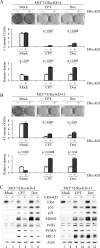p53, a target of estrogen receptor (ER) α, modulates DNA damage-induced growth suppression in ER-positive breast cancer cells
- PMID: 22787161
- PMCID: PMC3436267
- DOI: 10.1074/jbc.M112.367326
p53, a target of estrogen receptor (ER) α, modulates DNA damage-induced growth suppression in ER-positive breast cancer cells
Abstract
In response to genotoxic stress, the p53 tumor suppressor induces target genes for cell cycle arrest, apoptosis, and DNA repair. Although p53 is the most commonly mutated gene in all human cancers, it is only mutated in about 20% of breast cancers. 70% of all breast cancer cases are estrogen receptor (ER)-positive and express ERα. ER-positive breast cancer generally indicates good patient prognosis and treatment responsiveness with antiestrogens, such as tamoxifen. However, ER-positive breast cancer patients can experience loss or a reduction in ERα, which is associated with aggressive tumor growth, increased invasiveness, poor prognosis, and loss of p53 function. Consistent with this, we found that p53 is a target gene of ERα. Specifically, we found that knockdown of ERα decreases expression of p53 and its downstream targets, MDM2 and p21. In addition, we found that ERα activates p53 transcription via binding to estrogen response element half-sites within the p53 promoter. Moreover, we found that loss of ERα desensitizes, whereas ectopic expression of ERα sensitizes, breast cancer cells to DNA damage-induced growth suppression in a p53-dependent manner. Altogether, this study provides an insight into a feedback loop between ERα and p53 and a biological role of p53 in the DNA damage response in ER-positive breast cancers.
Figures







References
-
- Mosselman S., Polman J., Dijkema R. (1996) ERβ: identification and characterization of a novel human estrogen receptor. FEBS Lett. 392, 49–53 - PubMed
-
- Kuiper G. G., Carlsson B., Grandien K., Enmark E., Häggblad J., Nilsson S., Gustafsson J. A. (1997) Comparison of the ligand binding specificity and transcript tissue distribution of estrogen receptors α and β. Endocrinology 138, 863–870 - PubMed
-
- Stanford J. L., Szklo M., Brinton L. A. (1986) Estrogen receptors and breast cancer. Epidemiol. Rev. 8, 42–59 - PubMed
-
- Leygue E., Dotzlaw H., Watson P. H., Murphy L. C. (1998) Altered estrogen receptor α and β messenger RNA expression during human breast tumorigenesis. Cancer Res. 58, 3197–3201 - PubMed
Publication types
MeSH terms
Substances
Grants and funding
LinkOut - more resources
Full Text Sources
Medical
Research Materials
Miscellaneous

